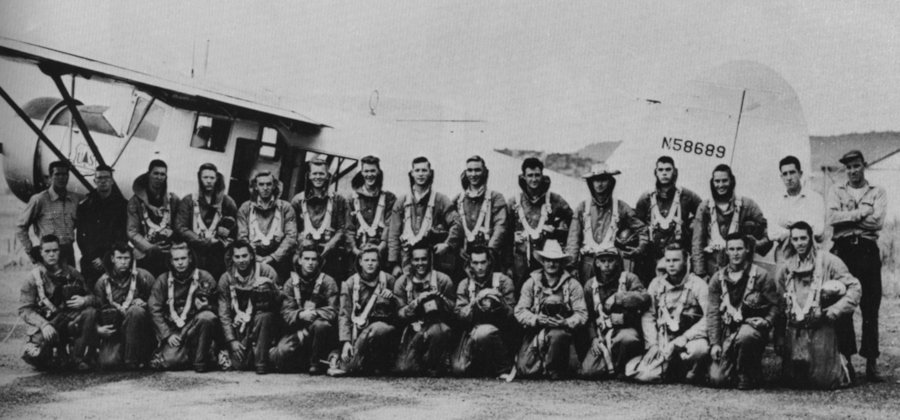How a Smokejumper Turned Astronaut Brought ‘Moon Trees’ Back to Earth

NASA astronaut Stuart Roosa took tree seeds to the moon on the Apollo 14 mission in 1971. He returned, and in collaboration with the US Forest Service, the germinated seeds were planted at more than 100 locations around the United States, including at the Siskiyou Smokejumper Base in Oregon where Roosa previously worked. Photos courtesy of NASA. Composite by Coffee or Die Magazine.
When NASA astronaut Stuart Roosa traveled to the moon on the Apollo 14 mission in 1971, the former US Forest Service smokejumper brought a small, sentimental science experiment along with him. While commander Alan Shepard and pilot Edgar Mitchell completed the third lunar landing mission, Roosa remained in the command module alone for 36 hours in lunar orbit.
Tucked in a container within Roosa’s flight suit were between 400 and 500 tree seeds. Following mission success, the Forest Service was to examine the condition of the germinated seeds before handing them over to NASA to plant as “moon trees.” The moon trees were planted around the US in 1975 and 1976 to celebrate the nation’s bicentennial.
The idea of the combined science experiment began soon after NASA chose Roosa for the mission. Roosa, who was raised in Oklahoma, worked as a smokejumper in the early 1950s before his career as an experimental test pilot in the US Air Force. When Roosa was selected for the Apollo program, USFS Chief Edward Cliff contacted him with the proposal. Soon, he introduced Roosa to geneticist Stan Krugman, who suggested the astronaut carry five important American tree species into space — the Douglas fir, loblolly pine, redwood, sycamore, and sweet gum.

Apollo 14 launched Jan. 31, 1971.
While alone in lunar orbit with his tree seeds nestled in his kit, Roosa listened to recorded tapes of his favorite country musicians and songs, including the Johnny Cash song “A Boy Named Sue.”
“I guess I’m just a hillbilly at heart,” Roosa told The New York Times in 1971. “I have always liked to fly by myself.”
After returning to Earth, the moon trees entered the decontamination process. However, the seeds’ original container had burst, and experts feared the worst. Krugman inspected the seeds to investigate the effects of prolonged weightlessness on seed germination and growth. To his surprise, nearly all the seeds were germinated. The seeds were subsequently planted in notable locations: a loblolly pine at the White House, a sycamore at Valley Forge, and a Douglas fir at the Siskiyou Smokejumper Base.

“This tree which was carried by Astronauts Stuart Roosa, Alan Shepard, and Edgar Mitchell on their mission to the Moon, is a living symbol of our spectacular human and scientific achievements,” President Gerald Ford said in a telegram. “It is a fitting tribute to our national space program which has brought out the best of American patriotism, dedication, and determination to succeed.”
Roosa retired from NASA in 1976 and worked in the international business field until his death in 1994. The moon trees, which are located in more than 100 locations around the US, remain an honorable tribute to Roosa and the Apollo program. Visit NASA’s website for a list of these locations.
Read Next:

Matt Fratus is a history staff writer for Coffee or Die. He prides himself on uncovering the most fascinating tales of history by sharing them through any means of engaging storytelling. He writes for his micro-blog @LateNightHistory on Instagram, where he shares the story behind the image. He is also the host of the Late Night History podcast. When not writing about history, Matt enjoys volunteering for One More Wave and rooting for Boston sports teams.
BRCC and Bad Moon Print Press team up for an exclusive, limited-edition T-shirt design!
BRCC partners with Team Room Design for an exclusive T-shirt release!
Thirty Seconds Out has partnered with BRCC for an exclusive shirt design invoking the God of Winter.
Lucas O'Hara of Grizzly Forge has teamed up with BRCC for a badass, exclusive Shirt Club T-shirt design featuring his most popular knife and tiomahawk.
Coffee or Die sits down with one of the graphic designers behind Black Rifle Coffee's signature look and vibe.
Biden will award the Medal of Honor to a Vietnam War Army helicopter pilot who risked his life to save a reconnaissance team from almost certain death.
Ever wonder how much Jack Mandaville would f*ck sh*t up if he went back in time? The American Revolution didn't even see him coming.
A nearly 200-year-old West Point time capsule that at first appeared to yield little more than dust contains hidden treasure, the US Military Academy said.












